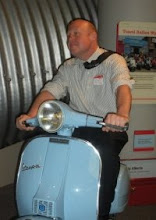In respnse to this postfrom Reach Advisors I posted a response that was long enough I am going to use it as a regular post to talk about an idea I had for training galleries for people new to the museum experience. Enjoy?
Wow. Is the visitor at fault...
When I taught school there was a sure fire way to tell someone who had no business teaching school. They complained about the students. They would go on how students did not arrive in the class with the requisite academic knowledge, manners, or they did not appreciate the pearls of wisdom that the state was mandating we ram into their minds .A standard joke with these burnout types was "This job would be great if it wasn't for two things: Parents and Students!"
So I believe any museum (and I really think that there are almost none who really think this) that suffers from a similar feeling about visitors is shooting itself in the foot. Those burnout teachers take advantage of a government run education system that fails to remove bad elements, and students are required by law to attending them. Museums don’t have ready made patrons who lack options.
Visitors are changing. Donors are changing. I think people are actually more apt to come to a museums today, but (and here is another school tie in) since NCLB schools have cut cut cut arts and culture. Children have no frame of reference, or idea of what a museum experience should be like. We are far enough into high stakes testing that new teachers even lack experiences with cultural institutions. So there is no indoctrination into this part of our society. Museums will have to do more of the indoctrinating.
I would like to suggest galleries with training wheels. What if there were a gallery with 3 paintings/sculptures/historic objects/natural history things? What if there were no labels with dates, artists and what the viewer should think, and feel? What if an educator took small groups and challenged the viewers to share their opinions, thoughts, and feelings about the pieces and provided positive feedback no matter the individual interpretation. What if they introduced ideas that others have written or published about the same work? Would this help people know what they were supposed to do with static works that do little more than sit there with no buttons, no way to tag, or thumb up or thumb down.? I think so.
You could still have more advanced galleries with less scaffolding. You could have interactive galleries with visitors able to engage and respond. Here you may find cell phone tours, places to jot down your reactions to showcased works, the traditional gallery tables with interactive activities, and maybe even some screens to touch or watch.
Other galleries could be dedicated as quiet zones. I think reverence for the Mona Lisa, Michal Angelo's David, not to mention Edward Hopper's Woman in the Sun would be an excellent idea. Museums would not assume everyone knew they were to zip it and stare at art in awe and bask in the brilliance of the creator. These are not innate, or even more advanced human traits. They are learned skills. Ones that museum should bring to the public. Signs or docents ( not chastising by saying “DON”T TALK EAT TAKE PHOTOS SPEAK OR BREATH IN THE PRESSENCE OF THE ALMIGHTY ART!”) would endeavor to explain to visitors the prized nature of what was on exhibition. Why society has deemed it important, rare or beautiful. That the public is invited to take in the images in a contemplative environ, and that this place is special to many and please keep that in mind as you look. Show your recognition by being respectful to your neighbor. This is what I would tell my students in The New Orlens Museum of Art, or The Birmingham Civil Rights Institute or at The Wall South. Small life lessons I was lucky enough to teach. We should all endeavor to share them at our own museums.
 image from ehow
image from ehow 
A gallery with training wheels! I love this idea. My institution has a small gallery space that has had the same black and photo exhibit up for almost two years. It's very casual and visitors like it for its historic context. However, I can envision enlisting the help of a local arts center to provide contemporary exhibition pieces without any labels, etc. I could rotate the exhibit to include contemporary art, historical objects, and historical photos. A gallery without labels... the possibility is rooted in constructivism learning.
ReplyDeleteAs a former kindergarten teacher and lover of Strong Museum, like John and his children, I understand what you mean about constructivist learning. How one sets up the environment very much influences how people respond to the environment. The museum which with I am affiliated, is an history museum. Yes, we can choose which artifacts or images to exhibit but in this case, I also think we need a certain balance of sharing information/ facts as well. I cannot construct history, I can however have responses and feelings. Michelle, by the way...I think we are roomates. Looking forward to meeting you!
ReplyDeleteAnna